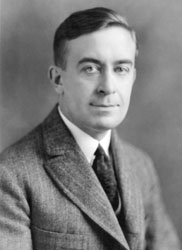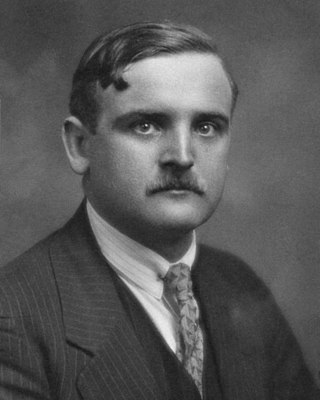
Plywood is a composite material manufactured from thin layers, or "plies", of wood veneer that are glued together with adjacent layers, having their wood grain rotated up to 90° to one another. It is an engineered wood from the family of manufactured boards, which include medium-density fibreboard (MDF), oriented strand board (OSB), and particle board.

The Hughes H-4 Hercules is a prototype strategic airlift flying boat designed and built by the Hughes Aircraft Company. Intended as a transatlantic flight transport for use during World War II, it was not completed in time to be used in the war. The aircraft made only one brief flight, on November 2, 1947, and the project never advanced beyond the single example produced.

Stitch and glue is a simple boat building method which uses plywood panels temporarily stitched together, typically with wire or zip-ties, and glued together permanently with epoxy resin. This type of construction can eliminate much of the need for frames or ribs. Plywood panels are cut to shape and stitched together to form an accurate hull shape without the need for forms or special tools. This technique is also called "tack and tape", or "stitch and tape". Seams are reinforced with fiberglass tape and thickened epoxy.

Particle board, also known as particleboard, chipboard, or low-density fiberboard, is an engineered wood product manufactured from wood chips and a synthetic resin or other suitable binder, which is pressed and extruded. Particle board is often confused with oriented strand board, a different type of fiberboard that uses machined wood flakes and offers more strength.

Aucoumea klaineana is a tree in the family Burseraceae, native to equatorial west Africa in Gabon, the Republic of the Congo, and Río Muni. It is a large hardwood tree growing to 30–40 m tall, rarely larger, with a trunk 1.0–2.5 m diameter above the often large basal buttresses. The tree generally grows in small stands, with the roots of the trees intertwined with neighboring trees. In Gabon, it is the primary timber species.

Laminated veneer lumber (LVL) is an engineered wood product that uses multiple layers of thin wood assembled with adhesives. It is typically used for headers, beams, rimboard, and edge-forming material. LVL offers several advantages over typical milled lumber: Made in a factory under controlled specifications, it is stronger, straighter, and more uniform. Due to its composite nature, it is much less likely than conventional lumber to warp, twist, bow, or shrink. LVL is a type of structural composite lumber, comparable to glued laminated timber (glulam) but with a higher allowable stress.

The Zephyr is a New Zealand one-design 3.35-metre (11.0 ft) sailing dinghy. Zephyrs are a national class, administered by the Zephyr Owners' Association. Hull form and sail plans are restricted, to ensure all boats have the same potential speed.
Fairey Marine Ltd, latterly known as FBM Marine, was a boat building company based on the River Hamble, Southampton, England. The company was created in the late 1940s by Sir Charles Richard Fairey and Fairey Aviation's managing director, Mr. Chichester-Smith. Both were avid sailing enthusiasts along with Chichester-Smith's good friend and former Olympic yachtsman, Charles Currey.

Wood flooring is any product manufactured from timber that is designed for use as flooring, either structural or aesthetic. Wood is a common choice as a flooring material and can come in various styles, colors, cuts, and species. Bamboo flooring is often considered a form of wood flooring, although it is made from bamboo rather than timber.
Aerolite is a urea-formaldehyde gap filling adhesive which is water- and heat-resistant. It is used in large quantities by the chipboard industry and also by wooden boat builders for its high strength and durability. It is also used in joinery, veneering and general woodwork assembly. Aerolite has also been used for wooden aircraft construction, and a properly made Aerolite joint is said to be three times stronger than spruce wood.

Alfred Victor Verville was an American aviation pioneer and aircraft designer who contributed to civilian and military aviation. During his forty-seven years in the aviation industry, he was responsible for the design and development of nearly twenty commercial and military airplanes. Verville is known for designing flying boats, military racing airplanes, and a series of commercial cabin airplanes. His planes were awarded with the Pulitzer Speed Classic Trophy in 1920 and 1924.

The General Aeroplane Company was Detroit's first commercial airplane builder. GAC built three types of aircraft during the First World War and operated a flying school. The aircraft were the Verville Flying Boat, the Gamma S biplane with floats (floatplane), and the Gamma L biplane with wheels. All had engine installations driving pusher propellers.

Eugene Luther "Gene" Vidal was an American commercial aviation pioneer, New Deal official, inventor, and athlete. For eight years, from 1929 to 1937, he worked closely with Amelia Earhart in a number of aviation-related enterprises, and was President Franklin Roosevelt's top civil aviation director from 1933 to 1937.
Haskell is a purely functional programming language.
Tego film is an adhesive sheet used in the manufacture of waterproof plywood. It is applied dry and cured by heat, which allows for high-quality laminates that are free from internal voids and warping. Tego film plywood products were used in aircraft manufacture in Germany during World War II, and the loss of the plant during a 1943 bombing raid was a serious blow to several aircraft projects. Tego film was an invention of the Essen, Germany, firm of Th. Goldschmidt AG later Evonik Industries ).

Duramold is a composite material process developed by Virginius E. Clark. Birch or poplar plies are impregnated with phenolic resin and laminated together in a mold under heat and pressure for use as a lightweight structural material. Similar to plywood, Duramold and other lightweight composite materials like the similar Haskelite were considered critical during periods of material shortage in World War II, replacing scarce materials such as aluminum alloys and steel.

Ernest Lloyd Janney (1893–1941) was the Provisional Commander of the Canadian Aviation Corps between 1914 and 1915. Janney pushed for the establishment of a Canadian flying corps during the First World War.

House of Flavors is a manufacturer and retailer of ice cream based in Ludington, Michigan. It started as a dairy business as part of a farm operation before 1930. In 1935 the business had become known as Miller's Dairy and started expanding the operation. By the 1940s they processed milk, buttermilk, cottage cheese, and ice cream. In the late 1940s a businessman with a decade of dairy experience moved to Ludington from a city 60 miles south to become a partner of the existing business. He became the general manager and the name was changed to Park Dairy. The milk and butter segments of the business were sold off and the enterprise thereafter concentrated on just making ice cream.

The Haskelite Building, also known as the Haskell Manufacturing Company Building, is a former factory building located at 801 N. Rowe Street, Ludington, Mason County, Michigan. The building was added to the National Register of Historic Places on November 10, 2022. In 2022, the building was refurbished into residential apartments, known as the Lofts on Rowe.

















